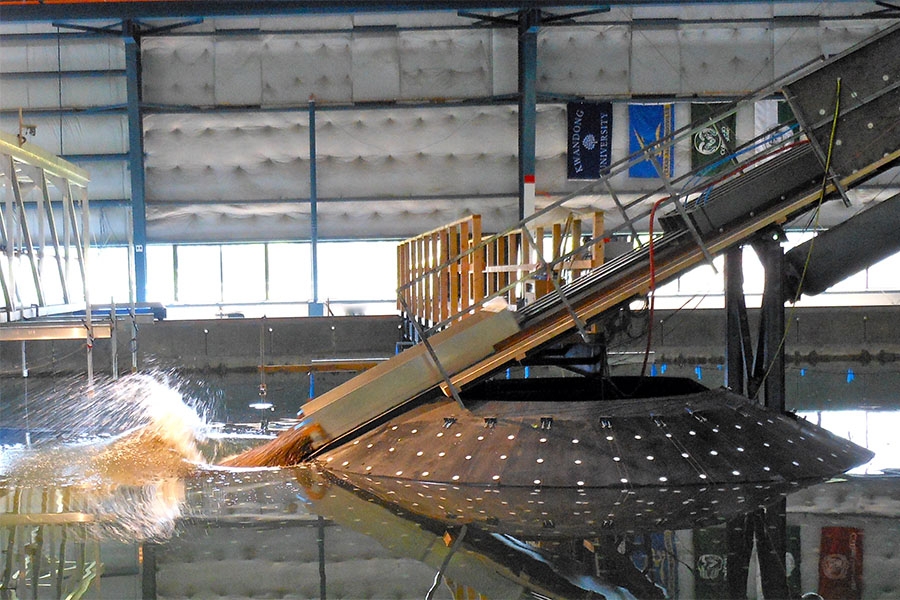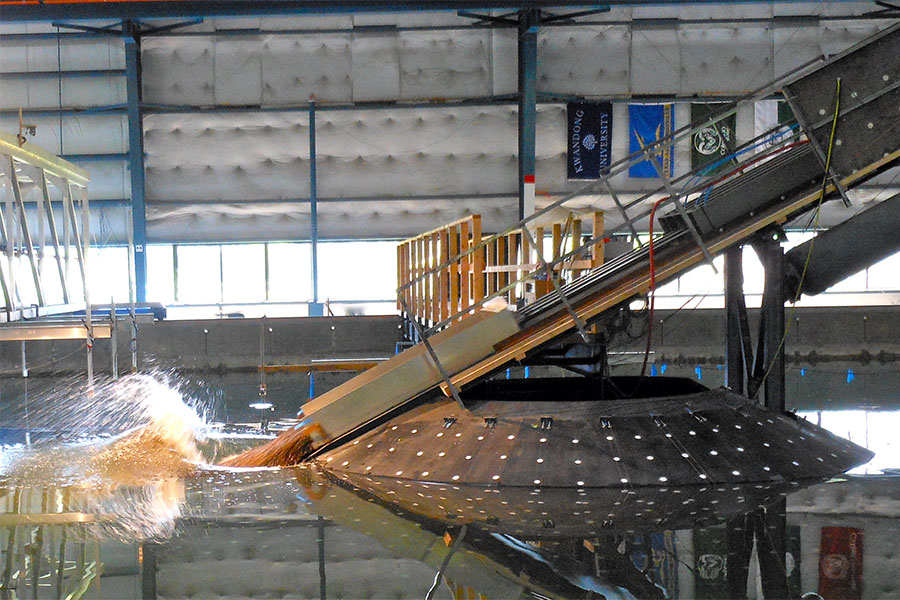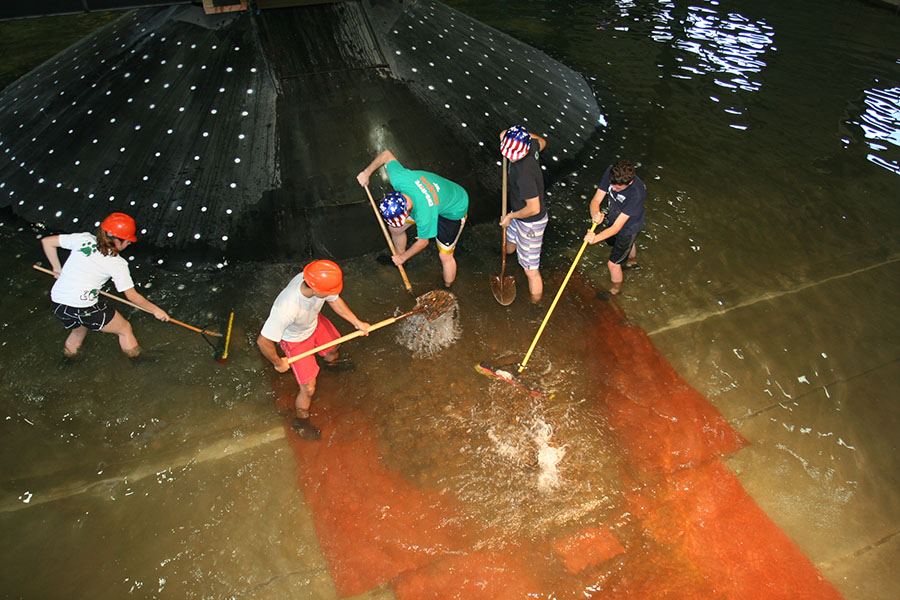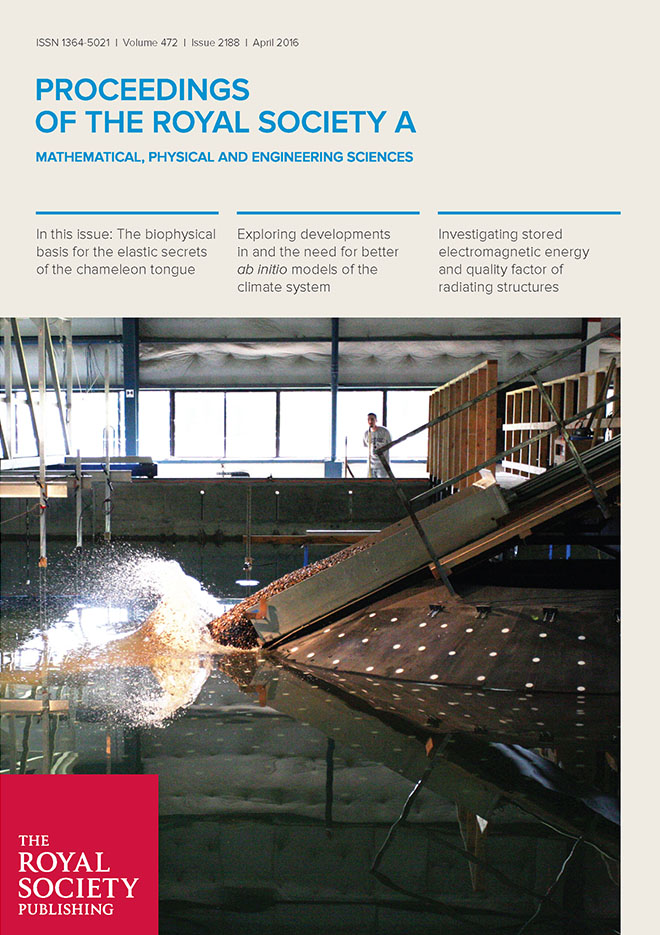
 A simulated landslide splashes into a wave basin at Oregon State University. School of Civil and Environmental Engineering researchers Hermann Fritz and Brian McFall used this unique apparatus to better understand landslide-generated tsunamis. They used two different sizes of rocks to create landslides, and they launched them down two different kinds of hills: a flat, or planar, hill and a conical hill, like a volcano. While rare, these kinds of tsunamis are especially dangerous, Fritz and McFall said. Their work made the cover of the Proceedings of the Royal Society A in April. (Photo: Hermann Fritz and Brian McFall) |
Scientists better understand the formation of rare but deadly kinds of tsunamis as a result of first-of-their-kind experiments by two Georgia Tech researchers.
“Tsunamis generated by landslides and volcanic island collapses account for some of the most catastrophic events in recorded history,” said Brian McFall, the lead author of the study, which was the result of his Ph.D. research. “Unfortunately, field data from these types of events is very limited.”
McFall’s experiments with School of Civil and Environmental Engineering Associate Professor Hermann Fritz allowed them to create equations to predict the characteristics of landslide-generated tsunamis. They can also assess the tsunami risk for coastal areas where there’s significant potential for a landslide.
Fritz said that’s important because these tsunamis, while rare, tend to be much larger in the immediate vicinity of the landslide than the more common tsunamis caused by earthquakes. They can impact coastlines within minutes, leaving little time for warnings, he said.
“Landslide-generated tsunamis can locally exceed tectonic tsunamis by an order of magnitude in wave height,” Fritz said, pointing to a 1958 tsunami in Lituya Bay, Alaska. That wave washed away all the trees and vegetation up to 1,700 feet above sea level, the largest-recorded tsunami runup in history.
“That is at least 10 times larger than the maximum runup heights from historic magnitude-9-plus earthquake-generated tsunamis, such as in Japan in 2011 or the Indian Ocean in 2004,” Fritz said.
He said it’s important to improve our understanding of such tsunamis because they pose a threat to areas where quake-generated tsunamis aren’t very common, like the coast along the Gulf of Mexico and the eastern seaboard of the United States.
The team’s study of simulated landslide-generated tsunamis made a splash as the cover article of the Proceedings of the Royal Society A in April.
McFall, who now works at the U.S. Army Engineer Research and Development Center, said researchers have had to depend on rare post-disaster field measurements, occasionally the readings from distant tide gauges, and eyewitness recollections to understand landslide-generated tsunamis’ evolution and how landslides influence the resulting waves.
“This project addressed this needed information by conducting the largest three-dimensional landslide-generated tsunami physical model ever created using granular landslide material,” McFall said.
McFall and Fritz used a unique landslide generator at Oregon State University to launch thousands of pounds of gravel and larger stones known as cobbles into a wave basin to create tsunamis.
Working with undergraduate researchers from universities across the country, they also simulated landslides on two different kinds of hills: a flat, or planar, hill, and a rounded conical hill such as on an island volcano.
“The results from these experiments were fascinating,” McFall said.
 Undergraduate researchers work to clean up after one of the tsunami experiments run by Hermann Fritz and Brian McFall. The tests launched rocks of different sizes into a wave basin at Oregon State University. Of course, someone has to remove all those rocks before the next test. (Photo: Hermann Fritz and Brian McFall) |
Though landslides transfer only a fraction of their power into creating tsunamis, “we found the cobble landslides transfer on average 43 percent more kinetic energy into the wave train than corresponding gravel landslides.”
McFall said they also found the leading wave crest is larger when landslides travel down a planar hill compared to a conical island. And they found differences in the resulting waves, depending on how fast the landslide impacted the wave basin. Faster impacts created a larger first wave crest, but the second wave was larger when the mass of rocks met the water at slower speeds.
This is the first time researchers have been able to use a model of this scale to quantify how the size of the rocks in a landslide and the shape of the hill affect the creation of tsunamis.
“The large-scale laboratory experiments allow us to fill the gaps in field data and study tsunami generation at the source along with the propagation and runup,” Fritz said. “The experimental data serves as benchmarks for numerical models and to advance numerical model developments.”

